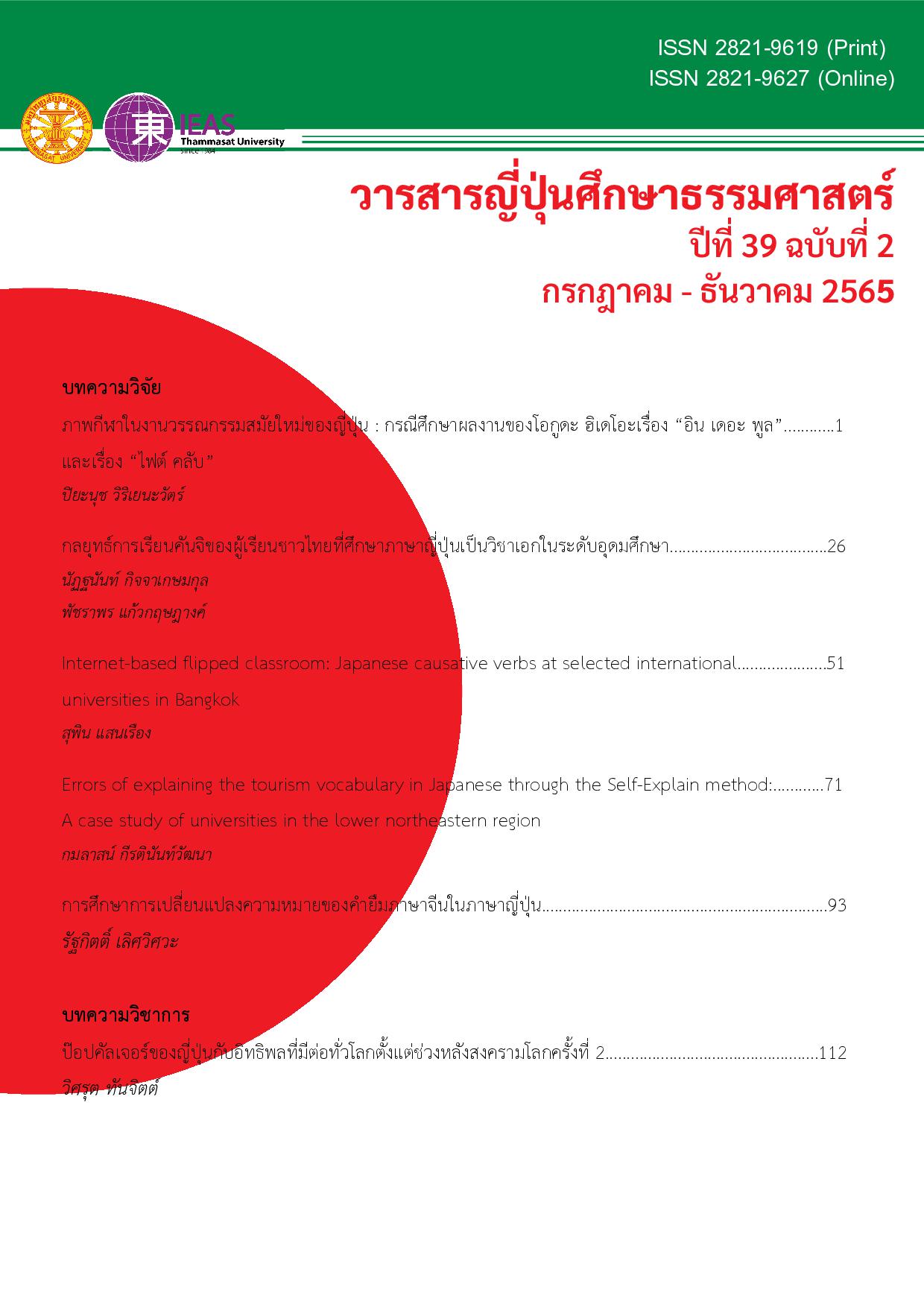Teaching Japanese Causative Verbs Via Hybrid Learning and Teaching
Keywords:
efficiency, effectiveness, Flipped Classroom, Japanese causative verbsAbstract
This study were to examine the efficiency and effectiveness of “Teaching Japanese Causative Verbs via Hybrid Teaching and Learning”. The sampling unit was 26 students of Japanese III in the first semester of the year 2021 at Assumption University of Thailand, and three experts. The qualitative data was gathered from the suggestions and comments from three experts using in-depth interviews whereas the quantitative data was obtained from student assessment tools with a pair samples t-test. The efficiency was proven by the E1/E2 formula. The finding showed the efficiency through E1/E2 score equaled 80.03/80.26 that meets the criteria 80/80. The effectiveness was proven through a statistically significant difference between pre-test and post-test, as seen from the p<0.05 level which corresponds to the hypothesis set. A five point Likert scale was used to measure satisfaction in the course content “Causative verb”. The satisfaction from three experts and students is in the “very satisfied” level with the average score of 4.5 and 4.32.
Downloads
References
Aycicek, B., & Yelken, T. Y. (2018). The effect of flipped classroom model on students’ classroom engagement in teaching English. International Journal of Instruction, 11(2), 385-398. https://doi.org/10.12973/iji.2018.11226a
Bamrungsetthapong, S., Tharnpanya, P., & Satjaharuthai, K. (2020). Hybrid learning and the quality improvement of Thailand’s education in the 21st Century. Narkbhutparitat Journal Nakhon Si Thammarat Rajabhat University. 12(3), 214-224. https://so04.tci-thaijo.org/index.php/nakboot/article/view/245900/168814
Banno, E., Ohno, Y., Sakane, Y., Shinagawa, C., & Tokashiki, K. (2003). An integrated course in elementary Japanese Genki. The Japan Times.
Bergmann, J., & Sams, A. (2012). Flip your classroom: Reach every student in every class every day. International Society for Technology in Education.
Bishop, J. L., & Verleger, M. A. (2013, June 23-26). The flipped classroom: A survey of the research. ASEE National Conference, Atlanta, GA.
Brahmawong, C. (2013). Developmental testing of media and instructional package. Silpakorn Educational Research Journal, 5(1), 7-20. http://www4.educ.su.ac.th/2013/images/stories/081957-02.pdf
Brown, B. A. (2016). Understanding the flipped classroom: Types, uses and reactions to a modern and evolving pedagogy. https://repository.stcloudstate.edu/ed_etds/12/
Carrasco, B., & Johnson, S. M. (2015). Hybrid language teaching in practice. Springer Briefs in Education.
Caulfield, J. (2011). How to design and teach a hybrid course. Stylus.
Cohen, S. (1987). Instructional alignment: Searching for a magic bullet. Educational Researcher, 16(8), 16-20. https://www.jstor.org/stable/1175370
Eggen, P. D., & Kauchak, D. P. (1996). Strategies for teachers: Teaching content and thinking skills (3rd.). Allyn & Bacon.
Gagne, R. M., Wager, W. W., Golas, K. C., & Keller, J. M. (2005). Principal of instructional design. Thomson Learning Academic Resource Center.
Graham, C. R. (2006). Blended learning systems: Definition, current trends, and future directions. Pfeiffer Publishing.
Iroi, I., Takanashi, S., Nakanishi, K., & Yamada, T. (2000). 初級を教える人のための日本語文法ハンドブック. 3A Corporation.
Johnson, L., Becker, S., Estrada, V., & Freeman, A. (2014). NMC horizon report: 2014 higher education edition. The New Media Consortium. https://www.learntechlib.org/p/130341/
Karnawati, R. A., & Istianingrum, A. (2021). The effectiveness of blended learning using the flipped classroom and hybrid learning models in the Chuukuuu Bunpou. Advances in Social Science, Education and Humanities Research, 518, 370-375. https://doi.org/10.2991/assehr.k.210120.147
Khruunan. (2020, May 16). 8 effective online teaching methods. Rakkhruu. https://rukkroo.com/24199/
Kiray, S.A., & Yildirim, F.S. (2016). Flipped classroom model in education. In W. Wu, S. Alan, & M. T. Hebebci (Eds.), Research highlights in education and science, 2016, (pp. 2-8). ISRES Publishing. https://www.researchgate.net/publication/335756684_FLIPPED_CLASSROO M_MODEL_IN_EDUCATION
Liming, Z., & Jianli, J. (2013). A study on effective hybrid math teaching strategies. International Journal of Innovation and Learning, 13(4), 451 – 466. DOI:10.1504/IJIL.2013.054239
Major changes in Thai education anticipated after the COVID-19 pandemic. (2020, June 16).
Office of National Higher Education Science Research and Innovation Policy Council.
https://www.nxpo.or.th/th/en/4841/
Online Lesson Practice Guide: 10 tips for assessing learning online. (2021). Department of Teaching & Learning Support, Center for Education in Liberal Arts and Sciences, Osaka University. https://www.dropbox.com/s/dtdh2ag1zqyowbd/10%20Tips%20for%20Assessing%20Learning%20Online.pdf?dl=0
Sujindawong, S. (2004). Item analysis method. Sripatum Journal, 4(1), 21-33. http://dspace.spu.ac.th/bitstream/123456789/1986/2/02.pdf
Snart, J. A. (2010). Hybrid learning: The perils and promise of blending online and face-to-face instruction in higher education. Praeger.
Tanaka, T. (1990). Guidance on Japanese grammar. Kindaibungeisha.
Thienthong, M. (2005). Design and computer courseware development. http://home.dsd.go.th/kamphaengphet/km/information/WBI/index.htm
Wang, X., Li, Z., Dong, L., & Li, W. (2022). The flipped classroom model of Japanese teaching based on intelligent decision-making system. Scientific Programming. 2022, 12 pages. https://doi.org/10.1155/2022/2792428.
Wayo, W., Charoennukul, A., Kankaynat, C., & Konyai, J. (2020). Online learning under the COVID-19 epidemic: Concepts and applications of teaching and learning management. Regional Health Promotion Center 9 Journal, 14(34), 285-298.
illustAC. (n.d.). 子供の発熱を心配するお母さん. https://www.ac- illust.com/main/search_result.php?word=%E7%9C%8B%E7%97%85%E7%96%B2%E3%82%8C
Hotel Sendai. (2012). 日本語教育のためのイラスト教材. http://skrykk.blog.fc2.com/blog-entry-62.html
日本語文型辞典. (1998). Kurosio Publishers. https://www.9640.jp/nihongo/ja/search/?search=7&key=%3C%E6%97%A5%E6%9C%AC%E8%AA%9E%E6%96%87%E5%9E%8B%E8%BE%9E%E5%85%B8%3E
みんなの日本語 II. (1998). 3A Cooperation.
Downloads
Published
Issue
Section
License
Copyright (c) 2022 Thammasat Journal of Japanese Studies

This work is licensed under a Creative Commons Attribution-NonCommercial-NoDerivatives 4.0 International License.




